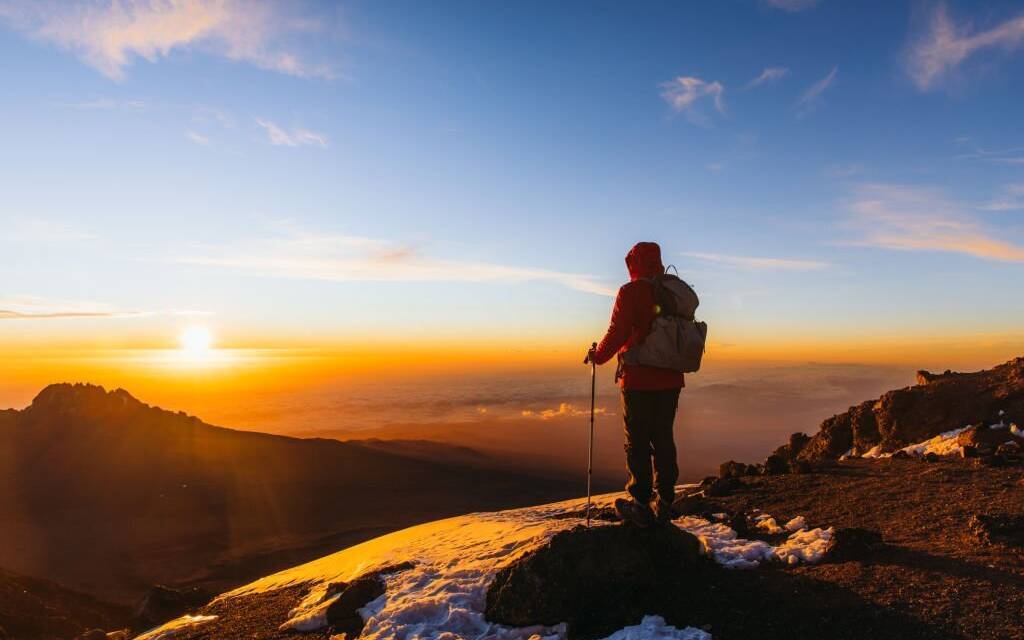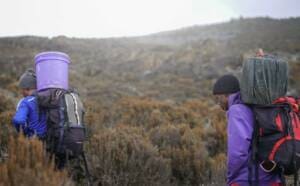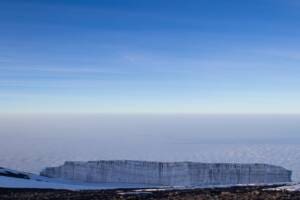Introduction
Mount Kilimanjaro
Mount Kilimanjaro, the highest peak in Africa, is a mystical beauty that has captured the imagination of adventurers and nature enthusiasts alike. The snow-capped summit, the lush greenery, and the stunning panoramic views of the surrounding plains make it a must-visit destination for anyone seeking an unforgettable experience. The journey to the top of this magnificent mountain is not just physically challenging but also a spiritual and emotional one. It is a journey of a lifetime that will test your endurance, push you to your limits, and reward you with a sense of achievement that you will cherish forever. As you trek through the diverse landscapes of Kilimanjaro, you will witness the beauty of nature in its purest form, and come face-to-face with its raw power. This adventure will take you on a journey of self-discovery, allowing you to reconnect with nature and appreciate the simple things in life. So, if you’re looking for a once-in-a-lifetime adventure, then the mystical beauty of Mount Kilimanjaro is waiting for you to conquer it.
Mount Kilimanjaro’s History and Significance
Mount Kilimanjaro is not just a mountain, it is a symbol of Africa’s natural beauty and cultural heritage. Located in Tanzania, it is the highest peak in Africa, standing at an impressive 5895 meters above sea level. The mountain is also a UNESCO World Heritage Site, recognized for its unique ecological and cultural significance.
The Chagga people, who have lived in the area for centuries, view Mount Kilimanjaro as a sacred mountain and believe that it is home to their god, Ngai. The mountain has played a significant role in their culture and traditions, and they have developed a close relationship with it over the years.
Mount Kilimanjaro has also been a source of inspiration for many writers, artists, and explorers. Ernest Hemingway wrote about his experiences climbing the mountain in his book, “The Snows of Kilimanjaro,” while Henry Morton Stanley was the first European to reach the summit in 1889. The mountain has also been the subject of many documentaries and films, including the award-winning documentary, “Kilimanjaro: To the Roof of Africa.”
The Splendor of Mount Kilimanjaro
At an impressive height of 5,895 meters (19,341 feet), Mount Kilimanjaro reigns supreme, commanding attention with its snow-capped summit and awe-inspiring vistas. This dormant volcano is a breathtaking sight to behold, rising majestically above the African plains. Its towering presence beckons adventurers from all corners of the globe to witness its beauty firsthand.
A Tapestry of Ecosystems
Mount Kilimanjaro is not just a single mountain but a collection of distinct ecological zones, each offering its unique wonders. As you ascend its slopes, you’ll journey through dense rainforests, vibrant moorlands, arid alpine deserts, and icy glaciers. The diversity of flora and fauna encountered along the way is astounding, making every step a remarkable encounter with nature’s marvels.

Unforgettable Hiking Trails
For hikers and outdoor enthusiasts, Mount Kilimanjaro is a dream come true. Numerous trails cater to different skill levels, ensuring there’s a route for everyone seeking an unforgettable adventure. The Machame and Marangu routes, among others, offer thrilling challenges, stunning landscapes, and the opportunity to conquer the summit. Each step taken brings you closer to an achievement of a lifetime.
Preparing for Your Journey
Preparing for a climb to the summit of Mount Kilimanjaro requires careful planning and preparation. Before embarking on your journey, you need to ensure that you are physically, mentally, and emotionally prepared for the challenge ahead.
The first step in preparing for your journey is to ensure that you are in good physical condition. Climbing Mount Kilimanjaro is a strenuous activity that requires a high level of fitness. You should engage in regular exercise, such as hiking, running, or cycling, to improve your endurance and stamina. You should also consider incorporating strength training exercises, such as weightlifting or yoga, to build your core strength and flexibility.
Mental preparation is also important when climbing Mount Kilimanjaro. You need to be mentally prepared for the physical challenge, as well as the emotional and spiritual journey that lies ahead. One way to prepare yourself mentally is to visualize yourself reaching the summit and achieving your goal. You should also practice positive self-talk and focus on the present moment rather than worrying about the future.
Finally, emotional preparation is key to a successful climb. Climbing Mount Kilimanjaro can be a life-changing experience, and you need to be prepared for the emotions that come with it. You may experience fear, doubt, and anxiety, but you should also be ready to experience joy, excitement, and a sense of accomplishment. It is important to be open to the emotions that arise during your journey and to embrace them with an open heart and mind.
Choosing a Route to Climb Mount Kilimanjaro
There are several routes to climb Mount Kilimanjaro, each with its unique features and challenges. The most popular routes are the Marangu, Machame, Lemosho, and Rongai routes.
Marangu route
The Marangu Route is a well-established trail to Mount Kilimanjaro’s summit. Known as the “Coca-Cola Route,” it provides amenities and huts for a comfortable experience. The trail starts at Marangu Gate and passes through rainforests, moorlands, and alpine deserts. Communal sleeping huts offer shelter along the way. Although less challenging, proper acclimatization and fitness are essential. The route allows cultural interactions with the Chagga people. Overall, the Marangu Route offers a classic path to Kilimanjaro’s summit with diverse landscapes and a comfortable trekking experience.
Machame route
The Machame Route is an adventurous trail to Mount Kilimanjaro’s summit. Starting from Machame Gate, it takes trekkers through diverse landscapes including rainforests, moorlands, and alpine deserts. The route offers stunning scenery and challenging terrain, appealing to experienced hikers. With proper acclimatization and breathtaking views, reaching the summit of Uhuru Peak becomes an unforgettable achievement. The
Lemosho route
The Lemosho Route offers a serene and less-crowded trek to Mount Kilimanjaro’s summit. With stunning landscapes, tranquil beauty, and unique wildlife encounters, it provides an unforgettable and intimate adventure. Experience breathtaking sunsets and immerse yourself in the scenic splendor of this remarkable route.
Rongai route
The Rongai Route offers a secluded and scenic trek to Kilimanjaro’s summit. With untouched wilderness, breathtaking views, and cultural encounters, it provides a unique and captivating adventure. Experience the beauty and tranquility of this lesser-known route to Africa’s highest peak.
When choosing a route to climb Mount Kilimanjaro, it is important to consider your fitness level, experience, and personal preferences. You should also consider the time of year, as the weather can vary depending on the season.
Tips for a Successful Climb
Climbing Mount Kilimanjaro is a challenging and rewarding experience, but it requires careful planning and preparation. Here are some tips to help you have a successful climb:
1. Train regularly: Prepare your body for the physical demands of climbing by engaging in regular exercise.
2. Pack appropriately: Pack light, but make sure you have everything you need for the journey, including warm clothing, hiking boots, and a sturdy backpack.
3. Stay hydrated: Drink plenty of water to prevent dehydration, which can lead to altitude sickness.
4. Take it slow: Climbing Mount Kilimanjaro is not a race. Take your time and enjoy the journey.
5. Listen to your body: Pay attention to your body and rest when needed. Don’t push yourself too hard or you risk getting sick.
6. Hire a reputable guide: A knowledgeable guide can make all the difference in a successful climb.
The Beauty of Mount Kilimanjaro’s Landscapes
Mount Kilimanjaro’s landscapes are diverse and stunning, ranging from lush rainforests to barren alpine deserts. Each stage of the climb offers a unique perspective of the mountain and its surrounding landscapes.
The first stage of the climb takes you through lush rainforests, filled with exotic wildlife, such as colobus monkeys and baboons. As you ascend higher, the landscape changes to moorlands and heathlands, characterized by rolling hills and grassy plains. The final stages of the climb take you through barren alpine deserts, with rocky terrain and stunning panoramic views of the surrounding plains.
One of the most breathtaking sights on Mount Kilimanjaro is the sunrise over the mountain. As the sun rises over the horizon, the snow-capped peak turns a brilliant shade of pink and orange, creating a stunning natural spectacle.
Wildlife on Mount Kilimanjaro
Mount Kilimanjaro is home to a diverse range of wildlife, including elephants, leopards, and buffalos. The lower slopes of the mountain are filled with lush rainforests, where you can spot exotic birds, monkeys, and other small animals.
As you climb higher, the landscape becomes more barren, but you may still spot wildlife such as hyenas, elands, and dik-diks. The higher elevations of the mountain are home to unique animal species, such as the Kilimanjaro tree frog and the Kilimanjaro shrew.
It is important to remember that Mount Kilimanjaro is a protected area, and visitors are required to adhere to strict regulations to protect the wildlife and their habitats.
Accommodations on Mount Kilimanjaro
Accommodations on Mount Kilimanjaro range from basic campsites to luxurious lodges. The Marangu route is known for its comfortable huts, while the Machame and Lemosho routes offer tented campsites with basic facilities.
If you prefer a more luxurious experience, you can choose to stay in one of the many lodges or hotels located near the mountain. These accommodations offer comfortable rooms, hot showers, and other modern amenities.
It is important to note that accommodations on Mount Kilimanjaro are limited, and it is recommended that you book well in advance to secure your spot.
The Importance of Responsible Tourism on Mount Kilimanjaro
Mount Kilimanjaro is a UNESCO World Heritage Site, and it is important to practice responsible tourism to protect the mountain and its surrounding ecosystems. Visitors are required to adhere to strict regulations, such as not littering, staying on designated trails, and respecting wildlife and their habitats.
It is also important to support local communities and businesses by hiring local guides and porters, purchasing locally-made souvenirs, and staying in locally-owned accommodations.
By practicing responsible tourism, we can ensure that Mount Kilimanjaro and its surrounding ecosystems remain protected for future generations to enjoy.
Conclusion
Climbing Mount Kilimanjaro is not just a physical challenge, it is also a spiritual and emotional journey of self-discovery. It requires careful planning and preparation, but the rewards are worth it.
The mystique of climbing Mount Kilimanjaro lies in the fact that it is not just about reaching the top, it is about the journey itself. As you trek through the diverse landscapes of Kilimanjaro, you will witness the beauty of nature in its purest form, and come face-to-face with its raw power. You will learn to appreciate the simple things in life, and reconnect with nature in a way that is impossible in our modern world.
Climbing Mount Kilimanjaro is a journey of a lifetime that will test your limits, push you to your boundaries, and reward you with a sense of achievement that you will cherish forever. So, if you’re looking for a once-in-a-lifetime adventure, then the mystical beauty of Mount Kilimanjaro is waiting for you to conquer it.






